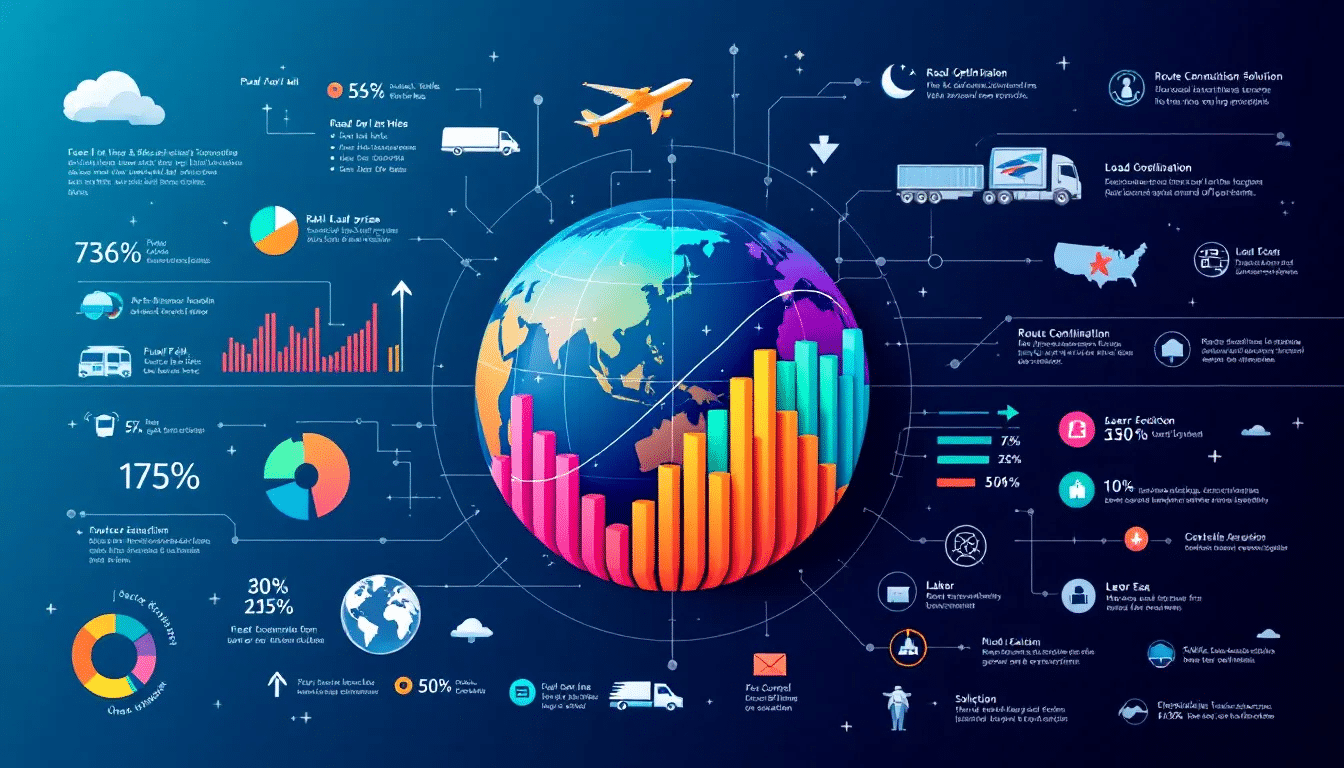Freight analytics is the process of collecting and analyzing shipment data to improve logistical efficiency and make data-driven decisions. It can help to reduce costs, optimize transportation routes, and enhance overall performance.
Freight analysis provides invaluable insights into how your business can improve by identifying weaknesses, finding inefficiencies, and helping you address them.
This article will explore key strategies for implementing freight analytics, discuss its benefits, and show you how to make data-driven decisions using freight data insights.
Key Takeaways
- Freight analytics leverages real-time data to enhance supply chain decision-making and operational efficiency by identifying trends and addressing inefficiencies.
- Key components for effective freight data analytics include an effective transportation management system, comprehensive data management, and high-quality data.
- Implementing predictive analytics allows companies to forecast demand, manage risks, and improve customer satisfaction through enhanced visibility and resource allocation.
What Is Freight Analytics?
Freight analytics involves the systematic collection, analysis, and interpretation of data related to the transportation of goods to improve operations. It’s a form of supply chain business intelligence whose goal is to analyze shipment, cost, and logistics data to provide data-backed insights in a fraction of the time it takes to process and analyze data manually.
Freight analytics relies on real-time data from tools like Transportation Management Systems (TSM) that provide simple reports you can use to identify market trends and highlight problems throughout your supply chain. This insight allows you to resolve them and optimize your performance as a whole.
The Four Types of Freight Data
Freight analytics can be categorized into four main types, each offering different levels of insight and decision-making support.
The four types of freight data include:
- Descriptive Data: Provides a historical overview of what has happened within the supply chain, helping to understand past performance.
- Diagnostic Data: Focuses on identifying the root causes of issues within the supply chain, enabling companies to address problems effectively.
- Predictive Data: Uses historical data and trends to forecast future events, allowing businesses to anticipate challenges and opportunities.
- Prescriptive Data: Offers recommendations for actions based on predictive analytics, guiding decision-makers toward the best possible outcomes
Together, these data types help you gain a complete understanding of logistics and create a plan to improve it.
What Are The Benefits of Freight Analytics?
Data is an incredibly important part of optimizing your business performance. With data, you can prioritize areas of improvement or specific metrics that need to improve to help protect your bottom line and boost effectiveness.
Freight analytics helps by providing data that supports a variety of initiatives, enabling benefits that include:
- Cost Reduction: Using data to find shipping errors, more efficient shipping routes, and package optimizations that reduce waste can all save you money.
- Improved Efficiency: Freight data tools help streamline operations by automating repetitive tasks like freight audit and payment and minimizing delays with proper routing and additional shipping services.
- Enhanced Decision-Making: Real-time data helps you adapt to changing conditions and overcome service disruptions as they happen, in addition to simplifying decisions about where to focus improvement efforts.
- Predictive Capabilities: Analyzing historical data helps predict seasonal demand fluctuations, delivery problems in specific locations, increased costs due to fuel prices, and more.
- Improved Customer Satisfaction: Improving the efficiency and reliability of your logistics processes leads to higher-quality deliveries that are on-time and damage-free.
These benefits, driven by the data insights provided by freight analytics, help you enhance your supply chain and become a more effective and efficient shipper. However, they rely on proper data management.
How to Practice Effective Freight Data Management
Effective freight analytics relies on robust data management practices that ensure your data is accurate, relevant, and actionable. This way, you can trust the insight it provides and move forward with confidence.
Data management revolves around three primary practices:
- Data Collection: The first step to managing data is collecting it from the various systems and tools you use for shipping. These come from your TMS, Internet of Things (IoT) devices, electronic data interchange (EDI), and financial software. Examples of data include carrier performance stats, fuel and shipping costs, routing data, inventory management information, and more.
- Data Consolidation: When you’re using data from a variety of tools and departments, it can create data silos that limit information accessibility. To avoid data silos, consolidate all of the information into a central repository so your tools see the entire picture of your supply chain, allowing it to offer the most valuable insights.
- Data Hygiene: Once you have all of your data consolidated, it’s important that you confirm its accuracy. Look for errors, duplicate data, and consistencies while standardizing data formats to simplify processing and avoid costly mistakes.
Freight data fuels comprehensive freight analytics, so ensuring you’re collecting, organizing, and cleansing your data improves the accuracy and effectiveness of your business intelligence solutions to improve outcomes.
How to Use Freight Analytics to Improve Supply Chain Efficiency
Freight analytics applies to most elements of your logistics and operations processes, allowing you to make impactful improvements that help you improve the efficiency and effectiveness of your supply chain.
Here are just a few ways you can use freight analytics:
- Tracking Shipping Costs: By monitoring and analyzing transportation costs over time through data analysis, you can determine whether your rates are fair or if you need to renegotiate your carrier contracts. You can also monitor invoices for billing errors that inflate your costs and work to recover them.
- Evaluating Carrier Performance: Stats like on-time delivery rates and damage rates help you determine whether a carrier is maintaining the service quality you expect.
- Forecasting Demand for Inventory Management: Historical data about shipment frequency can help you identify any seasonal demand changes that impact how much inventory you maintain.
- Overcoming Service Disruptions: The enhanced visibility into your logistics and live data makes it easier to identify potential obstacles like weather-related issues, allowing you to reroute deliveries or update customers instead of delivering late.
- Identifying Route Optimizations: Transportation management tools can simulate different shipping routes and compare them against your current routing to save you time, reduce environmental impacts, or lower your shipping costs.
All of these use cases have something in common: they rely on you making data-driven decisions about your logistics process so you can spend less and provide a better experience for your customers.
Why You Need to Partner With Business Intelligence Experts for Freight Analytics
Like most other business intelligence elements, freight analytics is a complex process that requires the right tools and knowledge to implement effectively. Without them, you won’t have data to analyze or the experience to know how to use the insights you gain to improve your business.
When you work with an experienced business intelligence solution provider, you gain access to their invaluable tools and understanding of how to leverage the data and insights it uncovers.
The right partner will help you:
- Identify the right data to track
- Implement data-collecting tools
- Integrate existing systems
- Ensure data accuracy
- Visualize data for reports
- Interpret data for improvements
- Monitor results for further insights
They’ll also help you implement the improvements you identify, ensuring those freight analytics insights translate to value for your business.
Case Study: Zero Down Saves Client 21.2% With Distribution Center Mapping
One positive change can make a huge difference for your business. But first, you need to know there’s a problem and find the solution.
At Zero Down, we analyzed our client’s shipping data to measure the impact an additional distribution center would have on their shipping costs. With our freight analysis and mapping software, we discovered that a well-placed secondary location would lower shipping costs by over 21%.
With this data-backed insight, they decided to add another location and reaped the rewards.
Leverage Freight Analytics to Make Smarter Decisions
Data is one of the most valuable resources you have as a business. It can help tell you what’s working, what needs improvement, and how you can optimize the processes that fall short–as long as you can break down the data and learn something from it.
Freight analytics empowers you to do just that. By transforming raw data into actionable insights, you can optimize your logistics, reduce costs, and improve efficiency. From carrier selection to route optimization to demand forecasting, the insight you gain is essential for making data-driven decisions that drive success.
With the right business intelligence partners by your side, you’ll have the resources and knowledge to find and make changes that help your business thrive in a rapidly evolving market.
Frequently Asked Questions
What is freight analytics?
A freight analysis involves analyzing extensive shipping datasets to uncover supply chain insights and respond to market trends so you can make informed decisions.
How can freight analytics reduce costs?
Insight from a freight analysis can significantly reduce costs by highlighting overcharges, identifying inefficiencies in routes, and optimizing packaging to reduce material waste to improve overall efficiency.
What is data management and why’s it important?
Data management includes the practices required to analyze your freight data for insights. It starts with collection from your systems and tools and then data consolidation to ensure all data is accessible. Then, you clean up the data to make sure it’s accurate and ready for analysis.
How does predictive analytics benefit freight management?
Predictive analytics significantly enhances freight management by enabling accurate demand forecasting and identifying potential disruptions, leading to optimized resource allocation and increased operational efficiency.
Why is partnering with industry experts important in freight analytics?
Partnering with industry experts is crucial because it significantly enhances business intelligence, ensures effective data utilization, and supports sustained growth.
Brad McBride, CEO and Founder of Zero Down Supply Chain Solutions is a dynamic leader with over 30 years of experience in the supply chain sector. His journey began at Consolidated Freightways in 1988, where he mastered freight logistics and pricing. His career led him to Eagle Global Logistics, diving into international freight forwarding and leading high-volume shipping projects.
Read More




